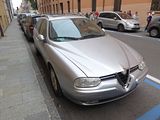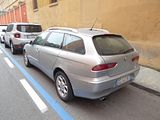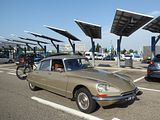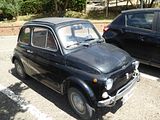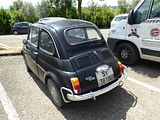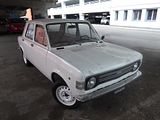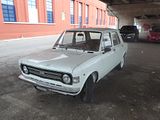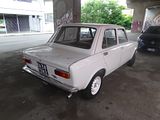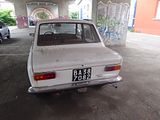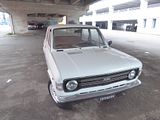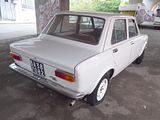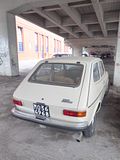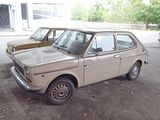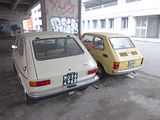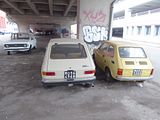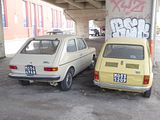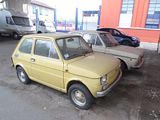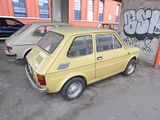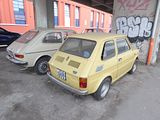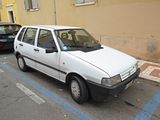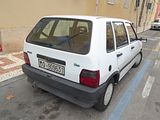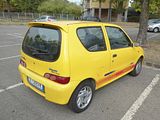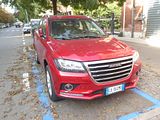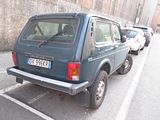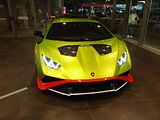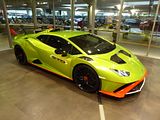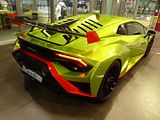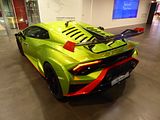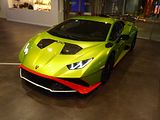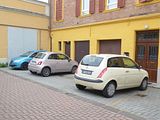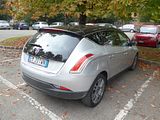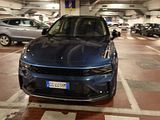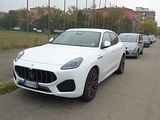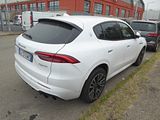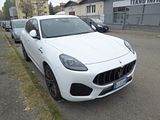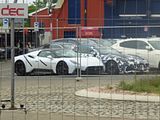You are always going to see large numbers the cars that were once common sightings on the road at car events, but whilst some are carefully stored away in garages and only emerge to be put on display at such gatherings others are still in daily service and thus by wandering around a large town, especially if there are residential areas in your route, you can expect to come across at least a few older models among all the modern and mundane. This is increasingly true in Europe the further south you go, where cars of 25, 30 or more years of age are not likely to have rusted away as they did in Northern Europe. Sadly though, scrappage schemes across much of Europe following the 2007/8 credit crunch and increasingly stringent emission zone restrictions in towns and cities have thinned out the older cars even in countries like southern France, Spain and Italy. But there are still some reminders of a bygone era around, and of course there are also those variations in the modern fleet based on national buying patterns that meant that a wander around the streets of a foreign country, with a camera will yield some cars that you would be unlikely to see back home. This report shows what I found on a recent trip to Italy, recording only those cars that I saw whilst on foot as opposed to driving. This was a short trip, so most of what is presented here comes from an afternoon stroll around the streets of Modena. Enjoy!
ABARTH
What is known as the Series 4 version of the familiar 595 reached the markets in the middle of 2016. After rumours had circulated all winter following the launch of the facelifted Fiat 500 last year, Abarth finally unveiled the Series 4 at the end of May 2016. Initially, we were told that the cars would not be available in the UK until September, but that came forward somewhat, with dealers all receiving demo cars in June, and the first customers taking delivery in July. Three regular production versions of both the closed car and the open-topped C were initially available, all badged 595, and called Custom, Turismo and Competizione, as before, though numerous limited edition models have since appeared and in most case disappeared. The most significant changes with the Series 4 are visual, with a couple of new colours, including the much asked for Modena Yellow and a different red, called Abarth Red, which replaces both the non-metallic Officina and – slightly surprisingly – the tri-coat pearlescent Cordolo Red. as well as styling changes front and rear. The jury is still out on these, with many, me included, remaining to be convinced. At the front, the new air intake does apparently allow around 15 – 20 % more air in and out, which will be welcome, as these cars do generate quite a lot of heat under the bonnet. Competizione models for the UK retain the old style headlights, as they have Xenon lights as standard, whereas the Custom and Turismo cars have reshaped units. At the back, there are new light clusters and a new rear bumper and diffuser. Inside, the most notable change is the replacement of the Blue & Me system with a more modern uConnect Audio set up, which brings a new colour screen to the dash. Mechanically, there is an additional 5 bhp on the Custom (now 145) and Turismo (now 165 bhp) and the option of a Limited Slip Diff for the Competizione, which is likely to prove a popular option. Details of the interior trim have changed, with a filled-in glovebox like the US market cars have always had, and electric windows switches that are like the US ones, as well as a part Alcantara trim to the steering wheel in Competizione cars. These cars have now been on offer for six years and with Abarth sales on the rise, and the fact that Italy is – at least sometimes – the biggest market for the cars, you might have expected to see more than the one example, but this is the only I saw on my wanderings.
ALFA ROMEO
When the 156 was launched in 1997, things looked very bright for Alfa. Striking good looks were matched by a driving experience that the press reckoned was better than any of its rivals. The car picked up the Car of the Year award at the end of the year. and when it went on sale in the UK in early 1998, waiting lists soon stretched out more than 12 months. Reflecting the way the market was going, Alfa put a diesel engine under the bonnet, launched a (not very good, it has to be admitted) automated transmission with the SeleSpeed, added a very pretty if not that commodious an estate model they called Sport Wagon and then added a top spec 3.2 litre GTA with its 250 bhp engine giving it a performance to outrun all its rivals. And yet, it did not take long before the press turned on the car, seduced by the latest 3 Series once more, citing build quality issues which were in fact far from universal. The 156 received a very minor facelift in 2002 and a more significant one in late 2003 with a new front end that was a clue to what would come with the car’s successor. Production ceased in 2005 and the cars have become relatively rare now.
CITROEN
It is hard to imagine just how revolutionary this car must have seemed when it was unveiled at the Paris Show in 1955. 18 years in secret development as the successor to the Traction Avant, the DS 19 stole the show, and within 15 minutes of opening, 743 orders were taken. By the end of the first day, that number had risen to 12,000. Contemporary journalists said the DS pushed the envelope in the ride vs. handling compromise possible in a motor vehicle. To a France still deep in reconstruction after the devastation of World War II, and also building its identity in the post-colonial world, the DS was a symbol of French ingenuity. It also posited the nation’s relevance in the Space Age, during the global race for technology of the Cold War. Structuralist philosopher Roland Barthes, in an essay about the car, said that it looked as if it had “fallen from the sky”. An American advertisement summarised this selling point: “It takes a special person to drive a special car”. Because they were owned by the technologically aggressive tyre manufacturer Michelin, Citroën had designed their cars around the technically superior radial tyre since 1948, and the DS was no exception. The car featured a novel hydropneumatic suspension including an automatic levelling system and variable ground clearance, developed in-house by Paul Magès. This suspension allowed the DS to travel quickly on the poor road surfaces common in France. In addition, the vehicle had power steering and a semi-automatic transmission (the transmission required no clutch pedal, but gears still had to be shifted by hand though the shift lever controlled a powered hydraulic shift mechanism in place of a mechanical linkage, and a fibreglass roof which lowered the centre of gravity and so reduced weight transfer. Inboard front brakes (as well as independent suspension) reduced unsprung weight. Different front and rear track widths and tyre sizes reduced the unequal tyre loading, which is well known to promote understeer, typical of front-engined and front-wheel drive cars. As with all French cars, the DS design was affected by the tax horsepower system, which effectively mandated very small engines. Unlike the Traction Avant predecessor, there was no top-of-range model with a powerful six-cylinder engine. Citroën had planned an air-cooled flat-6 engine for the car, but did not have the funds to put the prototype engine into production. The 1955 DS19 was 65% more expensive than the car it replaced, the Citroën Traction Avant. This did impact potential sales in a country still recovering economically from World War II, so a cheaper submodel, the Citroën ID, was introduced in 1957. The ID shared the DS’s body but was less powerful and luxurious. Although it shared the engine capacity of the DS engine (at this stage 1,911 cc), the ID provided a maximum power output of only 69 hp compared to the 75 hp claimed for the DS19. Power outputs were further differentiated in 1961 when the DS19 acquired a Weber-32 twin bodied carburettor, and the increasing availability of higher octane fuel enabled the manufacturer to increase the compression ratio from 7.5:1 to 8.5:1. A new DS19 now came with a promised 83 hp of power. The ID19 was also more traditional mechanically: it had no power steering and had conventional transmission and clutch instead of the DS’s hydraulically controlled set-up. Initially the basic ID19 was sold on the French market with a price saving of more than 25% against the DS, although the differential was reduced at the end of 1961 when the manufacturer quietly withdrew the entry level ID19 “Normale” from sale. An estate version was introduced in 1958. It was known by various names in different markets: Break in France, Safari and Estate in the UK, Wagon in the US, and Citroën Australia used the terms Safari and Station-Wagon. It had a steel roof to support the standard roof rack. ‘Familiales’ had a rear seat mounted further back in the cabin, with three folding seats between the front and rear squabs. The standard Break had two side-facing seats in the main load area at the back. During the 20 year production life, improvements were made on an ongoing basis. In September 1962, the DS was restyled with a more aerodynamically efficient nose, better ventilation and other improvements. It retained the open two headlamp appearance, but was available with an optional set of driving lights mounted on the front bumpers. A more luxurious Pallas trim came in for 1965 Named after the Greek goddess Pallas, this included comfort features such as better noise insulation, a more luxurious (and optional leather) upholstery and external trim embellishments. The cars were complex, and not always totally reliable, One of the issues that emerged during long term use was addressed with a change which came in for 1967. The original hydropneumatic system used a vegetable oil liquide hydraulique végétal (LHV), similar to that used in other cars at the time, but later switched to a synthetic fluid liquide hydraulique synthétique (LHS). Both of these had the disadvantage that they are hygroscopic, as is the case with most brake fluids. Disuse allows water to enter the hydraulic components causing deterioration and expensive maintenance work. The difficulty with hygroscopic hydraulic fluid was exacerbated in the DS/ID due to the extreme rise and fall in the fluid level in the reservoir, which went from nearly full to nearly empty when the suspension extended to maximum height and the six accumulators in the system filled with fluid. With every “inhalation” of fresh moisture- (and dust-) laden air, the fluid absorbed more water. For the 1967 model year, Citroën introduced a new mineral oil-based fluid liquide hydraulique minéral (LHM). This fluid was much less harsh on the system. LHM remained in use within Citroën until the Xantia was discontinued in 2001. LHM required completely different materials for the seals. Using either fluid in the incorrect system would completely destroy the hydraulic seals very quickly. To help avoid this problem, Citroën added a bright green dye to the LHM fluid and also painted all hydraulic elements bright green. The former LHS parts were painted black. All models, including the Safari and ID, were upgraded at the same time. The hydraulic fluid changed to the technically superior LHM (Liquide Hydraulique Minéral) in all markets except the US and Canada, where the change did not take place until January 1969, due to local regulations. Rarest and most collectable of all DS variants, a convertible was offered from 1958 until 1973. The Cabriolet d’Usine (factory convertible) were built by French carrossier Henri Chapron, for the Citroën dealer network. It was an expensive car, so only 1,365 were sold. These DS convertibles used a special frame which was reinforced on the sidemembers and rear suspension swingarm bearing box, similar to, but not identical to the Break/Safari frame. I saw this one at a service area on the autostrada and the owner very kindly paused when he saw me aim the camera at his car.
Most of the cars in this report are Italian in origin, but I did also spot this, a Citroen C-Elysée, a model not sold in the UK. Now on its second generation, the Citroën C-Elysée, is built in Vigo, Spain, along with the Peugeot 301, on which it is based, for markets in North Africa, South America and Western Europe (Belgium, France and Luxembourg), Eastern Europe and Southern Europe. The C-Elysée is also manufactured in China, as its predecessor had been.
FIAT
Known as project 110, the brief for the Nuova 500 was to create a micro-car that would not only carry on the tradition of the earlier Topolino, but which would also take sales away from the ever popular Lambretta and Vespa scooters of the day. It clearly needed to be smaller than the 600 which had been released with a conventional 4 cylinder engine. Not an easy task, but development started in 1953 and by August 1954, two designs were ready to be shown to Fiat management. They selected one, and serious development began. At first the car was referred to as the 400, as it was going to have a 400cc engine, but it was soon realised that this was just too small, so a larger 500cc air-cooled engine was developed. It was signed off in January 1956, with production starting in March 1957 in advance of a June launch. Fiat’s marketing department got busy, with hundreds of the new car taking to the streets of Turin, each with a pretty girl standing through the open sunroof that was a feature of all the early cars. The press loved it. 50 units were shipped to Britain, where the car made its debut at Brands Hatch, and again the reception was enthusiastic. But the orders just did not come in. Fiat went for a hasty rethink, relaunching the car at the Turin Show later that year. power was increased from 13 to 15 bhp, and the poverty spec was lessened a little, with headlight bezels, brightwork on the side and chrome hubcaps, a Nuova500 badge on the engine cover, winding side windows (the launch cars just had opening quarterlights) and the option of a heater fan. It was enough to get sales moving. The original car was still offered, at a lower price, called the Economy. In the first year of production, 28,452 Fiat 500s were made. Over the next 19 years, the car changed little in overall appearance, but there were a number of updates with more power and equipment added. A 500 Sport was launched in August 1958, with a more powerful version of the 499cc engine. It lost the soft top, having a ridged steel roof, to increase strength of the body. It was only available in grey with a red side flash. The first major changes came in 1960 with the 500D. This looks very similar to the Nuova, but with two key differences. One is the engine size: the D features an uprated 499 cc engine producing 17 bhp as standard, an engine which would be used right through until the end of the L in 1973; and the other is the roof: the standard D roof does not fold back as far as the roof on the Nuova, though it was also available as the “Transformable” with the same roof as the Nuova. The D still featured “suicide doors”. There were larger rear light clusters, more space in the front boot thanks to a redesign of the fuel tank and new indicators under the headlights. A year later, Fiat added a light on the rear-view mirrors and a windscreen washer, but the car still lacked a fuel gauge. Sales increased from 20,900 in 1960 to 87.000 in 1961, 132,000 in 1962 and by 1964, the last year of production, they hit 194,000 units. The D was replaced in 1965 by the 500F, which finally moved the door hinges from back to the front, owing to changes in Italian safety laws. There was a deeper windscreen and thinner door pillars, which increased the height of the car by 10mm, improving visibility for the driver. The 500F ran through to 1975, from 1968 alongside the more luxurious 500L which was added to the range in 1968. The L is easy to tell apart, with its bumper overriders. The final updates created the 500R, which incorporated many changes from the 126 under the skin of the classic shape, and in this form production continued alongside the newer 126 until 1976. Considering that it is over 45 years since production ceased, you still surprising numbers of this adorable little car in use across Italy.
This 128 was in the same spot, under the road bridge right next to the Maserati factory where I had seen it earlier the year, and with a flat rear tyre, I suspect it had not moved at all in the intervening months. Named European Car of the Year in 1970, over three million were manufactured, but few are left.. Introduced in 1969, it was built in an entirely new plant in Rivalta, north-west of Turin, specifically to manufacture the car. With engineering by Dante Giacosa and engine design by Aurelio Lampredi, the 128 was noted for its relatively roomy passenger and cargo volume — enabled by a breakthrough innovation to the front-engine, front-drive layout which became the layout “adopted by virtually every other manufacturer in the world”. Front-wheel drive had previously been introduced to small, inexpensive cars with the British Mini. As engineered by Alec Issigonis, the compact arrangement located the transmission and engine sharing a single oil sump — despite disparate lubricating requirements — and had the engine’s radiator mounted to the side of the engine, away from the flow of fresh air and drawing heated rather than cool air over the engine. The layout often required the engine be removed to service the clutch. As engineered by Dante Giacosa, the 128 featured a transverse-mounted engine with unequal length drive shafts and an innovative clutch release mechanism. The layout enabled the engine and gearbox to be located side by side without sharing lubricating fluid while orienting an electrically controlled cooling fan toward fresh air flow. Fiat tested this then new engineering for a full five years in the Autobianchi Primula, Fiat’s less market-critical subsidiary, Autobianchi which allowed them to sufficiently resolve the layout’s disadvantages, including uneven side-to-side power transmission, uneven tyre wear and potential torque steer, the tendency for the power of the engine alone to steer the car under heavy acceleration. The compact and efficient layout — a transversely-mounted engine with transmission mounted beside the engine driving the front wheels through an offset final-drive and unequal-length driveshafts — subsequently became common with competitors and arguably an industry standard. The 128 used an all new 1.1 litre Fiat SOHC engine, engineered by noted engine designer Aurelio Lampredi, featuring an iron block mated to an aluminium head along with a belt-driven single overhead camshaft producing 49 hp. The 128 was styled similarly to the 124 and 125 and featured rack-and-pinion steering, front disc brakes, independent rear suspension with a transverse leaf spring, and a strut-type front suspension with integral anti-roll bar. Initially, the 128 was available as a two-door or four-door sedan. At the 1970 Turin Motor Show a three-door station wagon model called “Familiare” was added to the line-up. The car was only available with a 1116 cc engine on launch, though the two-door-only 128 Rally edition launched in 1971 used a 1,290 cc unit. Also in 1971, the Sport Coupé, an all-new coupé body on a shortened 128 platform, was unveiled at the Turin Show. On launch it was available with both existing 128 engines. The 128 range underwent a facelift in 1972, featuring a revised grille. 1974 saw the launch of the 128 Special, which used the Rally engine in a four-door sedan body. In 1975 the 128 3P (3-door) Berlinetta replaced the Sport Coupé. In 1976, the range received new bumpers, rectangular headlights, tail lights and dashboard as well as modifications to the engines. At this time, the estate was also renamed the “Panorama”. Production of all 128s except that of the base 1,100 cc powered model ended in 1979 after the introduction of the Fiat Ritmo/Strada in 1978. In 1980 production of the small three-door station wagon Panorama was dropped from the range and 128 production finally ended in 1985
This time it was joined by a couple of other classic Fiat models from the 1970s. Developed towards the end of the 1960s, the Fiat 127 was launched as a two-door saloon in April 1971. A three-door hatchback, using an identical body profile but with a full-depth rear door and folding rear seat, was launched the following year; this would prove to be the most popular version of the 127. This was Fiat’s first supermini-sized hatchback, along with a state-of-the-art transverse-engine/front-wheel-drive layout, with the transmission mounted on the end of the engine, both design ideas had been fully trialled since 1964, by Fiat’s Autobianchi subsidiary with the Autobianchi Primula and 1969 Autobianchi A112 and A111 – although these models were not as widely exported as the 127 was. The larger Fiat 128, launched in 1969, was the first Fiat badged car to use the same transverse powertrain layout. The 127 used, as the A112, a shrunken version of the 128 platform and the rugged Fiat OHV 100 series 903 cc engine, that had powered the Autobianchi and, with various cylinder capacities, earlier generations of Fiat cars. The 127 also featured a unique transverse leaf spring suspension at the rear. Safety was another area of innovation – the 127 included an articulated steering column and crumple zones for progressive deformation under impact. The car was one of the first of the modern superminis, and won praise for its utilisation of space (80 percent of the floor space was available for passengers and luggage) as well as its road-holding. It was launched a year before the comparable Renault 5, and before the end of the 1970s most mass market European manufacturers were producing similar cars, notable examples being the Ford Fiesta and Volkswagen Polo, while General Motors added a three-door hatchback to the Opel Kadett range, which was reworked for British production and sold as the Vauxhall Chevette. The 127 was also one of the more popular imported cars on the UK market, peaking at more than 20,000 sales in 1978. It was also the first car fitted with an all-polypropylene bumper on steel support. The 127 was an instant success, winning the European Car of the Year award for 1972, and quickly became one of the best-selling cars in Europe for several years. It was the third Fiat in six years to receive this accolade. In June 1974, slightly over three years after the model’s introduction, Fiat reported that the one millionth 127 had been completed at the Mirafiori plant in Turin, after just over three years in production. The (in its time) hugely successful Fiat 600 had taken seven years to reach that same milestone. The Series 1 car changed little during its lifetime. However, in May 1973 saloons became available in both standard and deluxe versions. In 1975 the 127 Special variant was released which featured a restyled front grille and detail changes to the interior. The deluxe version was differentiated by its reclining front seats and opening hinged rear side windows as standard equipment. During the next couple of years the Fiat 850, which had initially been marketed alongside the 127, was withdrawn from most markets. The Series 2 version of the 127 debuted in May 1977. It featured a restyled front and rear, a new dashboard (although almost identical in layout to that of the Series 1), larger rear side windows (using rear quarter pressings derived from those used on the Brazil market Fiat 147) and the option of the 1049 cc engine – uniquely for the 127 this was the five-bearing OHC “Brazil” 124 series engine from the 147 rather than the Fiat OHC unit from the 128. The tailgate was extended and now reached nearly to the rear bumper, addressing complaints about the high lip over which luggage had to be lifted for loading into the earlier 127 hatchbacks. A short-lived Series 3 came early in 1982, but when the Uno followed it just a year later, the car was deleted from most European markets.
The 126 arrived in the autumn of 1972 and was produced alongside the 500, which stayed in production until 1976. The 126 used much of the same mechanical underpinnings and layout as its Fiat 500 rear-engined predecessor with which it shared its wheelbase, but featured an all new bodyshell resembling a scaled-down Fiat 127, also enhancing safety. Engine capacity was increased from 594 cc to 652 cc at the end of 1977 when the cylinder bore was increased from 73.5 to 77 mm. Claimed power output was unchanged at 23 PS, but torque was increased from 39 N·m (29 lb/ft) to 43 Nm (32 lb/ft). A slightly less basic DeVille version arrived at the same time, identified by its large black plastic bumpers and side rubbing strips. A subsequent increase in engine size to 704 cc occurred with the introduction of the 126 Bis in 1987. This had 26 PS, and a water cooled engine, as well as a rear hatchback. Initially the car was produced in Italy in the plants of Cassino and Termini Imerese, with 1,352,912 of the cars made in Italy, but from 1979, production was concentrated solely in Poland, where the car had been manufactured by FSM since 1973 as the Polski Fiat 126p. Even after the introduction of the 126 Bis the original model continued to be produced for the Polish market. The car was also produced under licence by Zastava in Yugoslavia. Western European sales ceased in 1991, ready for the launch of the Cinquecento, but the car continued to be made for the Polish market. In 1994, the 126p received another facelift, and some parts from the Fiat Cinquecento, this version was named 126 EL. The 126 ELX introduced a catalytic converter. Despite clever marketing, the 126 never achieved the popularity of the 500, with the total number produced being: 1,352,912 in Italy, 3,318,674 in Poland, 2,069 in Austria, and an unknown number in Yugoslavia.
Fiat launched the Uno, the Tipo 146, in January 1983, just one day before the equally iconic Peugeot 205, to replace the elderly Fiat 127. Both were huge sellers, and deservedly so too, but it was the Fiat that sold in greater quantity, with over 8 million examples produced. It was Italy’s best selling car, and by some margin, throughout its 10 year production life, though you might find that hard to believe now, as they were are not a common sight even in Italy. The 127 had revolutionised the supermini market on its launch more than 10 years earlier, and the Uno followed the same format, but brought uptodate. Designed by Giorgetto Giugiaro’s ItalDesign company, its tall, square body utilising a Kamm tail achieved a low drag coefficient of 0.34 won it much praise for interior space and fuel economy as well as its excellent ride and handling, and was widely regarded as the most innovative small car in Europe at the time of its launch. It incorporated many packaging lessons learnt from Giugiaro’s 1978 Lancia Megagamma concept car (the first modern people carrier / MPV / mini-van) but miniaturised. Its tall car / high seating packaging is imitated by every small car today. It reversed the trend for lower and lower built cars. It showed that not just low sleek cars could be aerodynamic, but small, roomy, boxy well packaged cars could be too. There was a lot of activity in the supermini class in 1983, as the Uno hit the UK market a couple of months before the Peugeot 205 – another small European car which became the benchmark for this market sector, enjoying a long production life and strong sales, and just after General Motors launched its new Opel Corsa/Vauxhall Nova. Within a few months of its launch it had gained two new major competitors in the shape of the restyled Ford Fiesta and Nissan’s new Micra. UK sales began in June 1983, and more than 20,000 were sold in its first full year and peaking at more than 40,000 sales in 1988, making it one of the UK’s most popular imported cars during the 1980s. In December 1983, it was European Car of the Year for 1984, finishing narrowly ahead of the Peugeot 205. Initially, the Uno was offered with the 0.9 litre (903 cc) 100-series OHV, 1.1 litre (1116 cc) and 1.3 litre (1301 cc) 128-series SOHC petrol engines and transmissions carried over from the 127. The Uno’s badging was not by the commonly used measurement of engine size but by metric horsepower: 45, 55, 60, 70, or 75. The Uno was available as either a three- or five-door hatchback. It also featured ergonomic “pod” switchgear clusters each side of the main instrument binnacle, (that could be operated without removing the driver’s hands from the steering wheel), although indicators remained on a stalk; an unusual arrangement similar to that used by Citroën. The Uno had MacPherson strut independent front suspension and twist-beam rear suspension with telescopic dampers and coil springs. From 1985, the 1.0 litre (999 cc) SOHC Fully Integrated Robotised Engine (FIRE) powerplant was offered, replacing the 0.9 litre unit. This was a lighter engine, built with fewer parts, and gave improved performance and economy. The most luxurious version, the single-point injected 75 SX i.e., had remote door locks, integrated front foglamps, and the oval exhaust tip also used on the Turbo. In April 1985 the hot hatch version of the first series Uno – the Uno Turbo i.e. – was launched as a three-door only derivative. It competed with the likes of the Ford Fiesta XR2, MG Metro Turbo and Peugeot 205 GTI. The Uno was replaced by the Punto in late 1993, although production for some markets continued for some time after that. These cars sold in huge numbers in Italy and for a long time after production ceased, you would see large numbers of them on the roads, but their numbers have thinned to a tiny proportion of the original quantity now.
Follow on to the Cinquecento was the Seicento, and that was represented here by the Sporting version, debuting in 1997. It did not differ much from its predecessor, retaining the same engines, chassis and general dimensions, although it did gain a minor 9 cm in length (total length of 3.34 m). At launch, the Seicento was available with three trim levels; a basic ‘S’ with black bumpers and spartan equipment and initially the 899 cc 39 PS FIAT 100 series engine; an ‘SX’ model, a slight upgrade over the ‘S’ with colour-coded bumpers, electric windows, central locking and a sunroof – which was also available as a ‘Citymatic’ with a clutchless manual gearchange – and a ‘Sporting’ with the larger FIAT FIRE series 1108 cc 55 PS engine, 20 mm (0.8 in) lower suspension and anti-roll bars added. Cosmetically, this version gained 13″ alloy wheels, sports seats. An Abarth styling kit was also available with a body kit with optional Abarth 14″ wheels a close-ratio gearbox, sill kick plates, embroidered headrests, leather gear stick and steering wheel, colour highlighted trim in the bumpers, side skirts and a spoiler also available. Both the sporting and the Abarths were available with ABS, air-conditioning and power steering but due to cost not very many owners took up the options. In 1999, the FIRE engine was used in the special ‘Suite’ version, which came with air-conditioning. A special edition ‘Soleil’ model was available in some markets, which was based on the ‘SX’ model but came with a full-length electrically-folding fabric roof. In 2001, after the update, all cars were given clear indicator lenses, with the Sporting model getting a restyled bodykit. Power steering was still an option, in lower end Seicentos. A ‘Michael Schumacher’ edition of the Sporting, with ABS and the Abarth styling kit, was also launched at this time to celebrate the Ferrari driver’s Formula One success, This model was almost identical to the Abarth kit with the exception of chrome gear stick surrounds and Michael’s signature on the boot lid and side skirt. A limited edition plate and number was also on the passenger door. In 2004, the model was withdrawn from the UK market, and production of RHD models ceased, following the arrival of the new and more practical Panda. The LHD model was facelifted, gaining a new design for the wheel rims and the introduction of the new Fiat logo to the rear. In 2005, the name Seicento was replaced by 600 (on the occasion of the 50th anniversary of the first edition, in 1955) together with some changes in the front and in versions donations: now the name Fiat is written on the seats. The new versions now were named “Class” and “50 anniversary”, thus reminding the strict relationship between this model and the previous one. Production continued until 2010 by which time over 1.33 million units had been built. There are stll good numbers of these on Italian roads, though the population would seem now to be reducing and most of the surviving cars are going through the increasingly tatty stage.
HAVAL
Chinese cars are starting to appear across Europe, but as the brands get established, most of them are taking the route of entering via one or two countries first rather than launching an assault across the entire continent. One of the brands now selling cars in Italy is Haval, one of the brands owned by Chinese company Great Wall, and which specialises in crossovers and SUVs. I saw quite a few of these, but generally had to look at the badge from close up to know what it was that I was looking at.
LADA
The Lada Niva Legend, formerly called the Lada Niva, VAZ-2121, VAZ-2131, and Lada 4×4 (Russian: ВАЗ-2121, ВАЗ-2131, Лада Нива), is a series of four-wheel drive, small (hatchback), and compact (wagon and pickup) off-road cars designed and produced by AvtoVAZ since 1977. Initially aimed at the rural market, later models also targeted urban users. The three- and later five-door 4×4 hatchbacks were sold under the Lada marque in many markets, and have been in continuous production since 1977. In the 1990s, three and five-door wagons on a 50 cm (20 in) longer wheelbase and an extra-long wheelbase pick-up were added to the range. After the original Land Rover and its successor, the Land Rover Defender, were discontinued in 2016, the Niva became the longest production run off-road light vehicle still manufactured in its original form. By the end of 2020, an estimated 650,000 Lada Nivas had been sold globally. The Lada Niva is the world’s first mass-produced off-road vehicle with a unibody construction (fully integrated body and frame).It is the predecessor of current crossover SUVs, most of which are built similarly. It was part inspiration for the Suzuki Vitara. In August 2020, Lada took over production of the 2003 Chevrolet Niva and rebranded it the “new” Lada Niva. In December 2020, the new Niva was further rebranded as the Lada Niva Travel, while the old model was renamed Lada Niva Legend in January 2021. The Niva was described by its designers as a “Renault 5 put on a Land Rover chassis”.[16] Development began in 1971 after the 24th Congress of the CPSU, in which Alexei Kosygin (the then-Premier of the Soviet Union) gave the designers at VAZ and AZLK the task of creating a car suitable for rural areas (specifically for the villagers and farmers of the Soviet Union), since the usual Zhiguli, Moskvitch, and Zaporozhets, intended primarily for ordinary people, were not much of use in the isolated areas that made up a large part of the USSR. In the same year, a team of VAZ designers led by Solovyev began competing with AZLK to work on a “civilized” four-wheel drive vehicle. The new car was partly inspired by the IZh-14 prototype of 1974.[18] It was VAZ’s first model that was not based on Fiat, though many of its mechanics were carried over from the earlier Fiat 124- or 125-based Zhiguli models (mostly the VAZ-2103 and 2106); the body, four-wheel drive system, and front suspension were all designed by VAZ. The first prototype appeared in 1971 and was officially designated the E-2121 and nicknamed krokodil (the crocodile) due to its distinctive frontal section, but was rejected for being too utilitarian, so doors and a hardtop were added. This version (designated the 2E-2121) debuted in 1973 and deviated from the off-road vehicles of the period, as it used a modern hatchback body. The design choice was inspired by the prototype known as the VAZ-1101 (itself derived from the Fiat 127), and was created by designer Valery Pavlovitch. The influence of the Fiat 127 is obvious from the Niva’s distinctive “clamshell” hood design and its rear three-quarter section. The 1974 prototype (designated the VAZ-2121M) was derived from an existing model, the VAZ-2103 (then the newest model in VAZ arsenal). It used the VAZ-2103’s 1,452 cc engine and shared some of its features, like chrome-plated bumpers, headlights and taillights, instruments, seats, and steering wheel. In the following year, two samples of the prototype were modified to install a 1,478 cc UZAM-412 engine, which originally powered the Moskvich 1500. Testing later revealed that the engine was incompatible with the newly designed car. The Moskvich engine was abandoned, and the older engine was reused. The 1974 prototype (2121M) was ready to be mass produced in 1975, but the appearance of the new VAZ-2106 at the end of the year resulted in a delay because the company wanted to develop another prototype based on the model in 1976, which became the sixth and final (serial production) prototype. Before its production, the Niva was tested over a period of years by a team led by Vadim Kotlyarov in the most difficult terrain of the Soviet Union, such as the Ural Mountains and Siberia, the deserts of the Kazakh SSR, and the Pamir Mountains in the Tajik SSR, where it was compared with its military counterpart, the UAZ-469, and some Western off-road vehicles—the British-made Land Rover Series and the Range Rover Classic. Its off-road capabilities were demonstrated for the very first time, which were based on its effective permanent four-wheel drive system featuring a transfer case and central differential lock, with the combination of a short wheelbase (only 2,2m), relatively low weight (just over a ton), independent suspension, small dimensions (3,74×1,68 m), and high ground clearance (about 265 mm). Its large but narrow wheels (175/80-R16 in dimensions), originally featuring domestically designed “Voltyre” VLI-5 high-tread tires, offered relatively strong ground pressure, which lowered the chances of slipping or getting bogged down off-road. For example, in the 1973 and 1974 trials, the Niva climbed a 58% slope, and crossed 60 cm (24 in) of water and 100 cm (39 in) of mud and snow. Solovyev died the following year and was replaced by engineer Pyotr Prusov, who took credit for creating the car. In 1976, the final prototype appeared. The engine was changed to a 1,568 cc (95.7 cu in) one, the most powerful engine in VAZ during the Soviet era, taken from their VAZ-2106 (from which the production model of the first Niva generation was generally derived). Like the previous prototype, it featured a permanent four-wheel drive and a transfer case with a lockable central differential. The VAZ prototype displayed better design and real-world performance than its AZLK counterpart, the Moskvitch 416, so it was approved for production in March of the same year, after the 25th Congress of the CPSU. The car was named Niva 1600 (Field) for exports and the VAZ-2121 (alternatively “Niva 2121” or “VAZ Niva”) for the domestic market. For domestic customers, it was described as “[a] high-speed car with the improved capabilities and comfort of all VAZ models,” and also as “[a] combination of the speed and comfort of a Zhiguli with the capabilities of a UAZ.” Production began the following year on 5 April 1977, while the first export models appeared in 1978 at the Paris Motor Salon and quickly took over at least 40% of Europe’s market for four-wheel drive vehicles, making it Lada’s top-selling export. It was the only Soviet car that was ever sold in Japan, starting from the early 1980s, inspiring their Suzuki Samurai. Because of export demand and the higher priority given to exports, domestic customers faced long wait times, despite the car being developed primarily for Soviet citizens.
LAMBORGHINI
This is a bit of a cheat, as I saw it at the Bologna Airport, where Lamborghini have a permanent display area in the arrivals hall. They usually have one or two examples of their latest production cars on show, and there’s typically a steady stream of people who pass by, stop and grab a photo or two. On this occasion it was he Huracan STO that they were displaying. The STO (Super Trofeo Omologato) is a track focused variant of the Huracan. It is completely different from other Huracan variants. The STO has a taller rear wing with a roof snorkel for engine cooling. There is a shark fin aerodynamic device connecting the roof snorkel with the rear wing. The engine cover is reminiscent of the Lamborghini Super Trofeo Evo race cars. The entire hood opens to reveal a small compartment for storing racing equipment, the body is made of 75% carbon fibre, the engine and the power output of the STO is the same as the Huracan Perfomante and the Huracan Evo but it has Rear-wheel drive with Rear Wheel Steering system, it has CCMR Brakes inspired from Formula 1. The STO comes with three new modes: STO for road driving, TROFEO for fast lap times on dry tarmac, and PIOGGIA for wet weather driving. The bucket seats on the interior feature racing harnesses.
LANCIA
The first generation Delta had been given a second lease of life by its rallying successes, but by the 1990s it was over ten years old and due replacement; its four-door saloon sibling, the Prisma, had already been replaced by the Lancia Dedra. By the time the new car was ready, Lancia had all but pulled out of the UK, so the car was never officially sold here. A few have since been brought in, though, and there were two of them here. Both are the three door HPE models, and are familiar sights at Italian car and other gatherings in the area. The “Nuova Delta” (Tipo 836)—always referred to by Lancia as Lancia δ with the lower-case Greek letter – was introduced at the Geneva Show in 1993, alongside the final “Evo 2” HF Integrale. Sales commenced in May 1993. Initially the Nuova Delta was offered with three engines and outputs varying from 76 to 142 PS: an entry level SOHC 1.6-litre, and two DOHC inline fours with Lancia’s twin counter rotating balance shafts, an 8-valve 1.8 and a 16-valve 2.0 litre. Trim levels were three: base and LE for the 1.6 and 1.8, base and richer LS for two-litre models. The sportier 2.0 HF was also unveiled in Geneva, but went on sale in September; it used a version of the 16-valve 2.0 litre equipped with a Garrett T3 turbocharger and an intercooler to produce 186 PS. Mechanical changes from the other Deltas included up-sized 205/50 tyres, stiffer suspension, standard 4-way ABS, a “Viscodrive” viscous coupling limited slip differential and, in the HF LS trim, electronically adjustable dampers with two settings. Visually the HF turbo was set apart by an eggcrate grille with a gunmetal surround and a yellow HF badge, a sportier front bumper complementing 1.1 inch wider front wings, black side skirts, specific 15 inch 7-spoke alloy wheels and a spoiler at the base of the rear window. Larger disk brakes and optional Alcantara Recaro sport seats were shared with the 2.0 LS. About a year after the launch, in June 1994, the 1.9 turbo ds turbodiesel variant was added to the range; it was powered by the usual 1,929 cc SOHC unit, pushing out 90 PS. The turbo ds was given the flared fenders and bumper of the HF, and was available in base and LE trim. Presented a month later and put on sale in autumn, the Delta 2.0 GT paired the naturally aspirated 2-litre engine with the looks of the HF—flared wings, bumper and spoiler. Although a three-door had been rumoured since 1991, it was not until the 1995 Geneva Motor Show that one became available. It was christened HPE—a denomination that had previously been used for a variant of the Lancia Beta, and standing for “High Performance Executive”. At first the HPE was only available with the three top engines: 2.0 16v, 1.9 turbodiesel and 2.0 16v turbo in HF guise. The three-door bodyshell had entirely redesigned body sides, but retained the roof and rear section of the five-door model; rear wheelarch flares complemented the HF-derived wide front wings and bumper, sported by all HPE versions. This meant the HPE was around 2.4 inches wider than a standard Delta, while all other exterior dimensions remained unchanged. Styling differences from the five-door included specific side skirts and a body-colour grille, to which the HPE 2.0 HF added all the accoutrements of the five-door HF and additional air intakes under the headlights. At the beginning of 1996 the range was updated. All naturally aspirated engines were replaced; the 1.6 and 1.8 8-valve by 16-valve units, while the 2.0 16v was discontinued in favour of a 1.8 16v equipped with variable valve timing. Trim levels for the 5-door were now three: base LE, richer LX and GT, exclusive to the 1.8 V.V.T. engine. The three-door HF turbo remained the only one offered, as the five-door version was discontinued. In addition to the turbocharged engines, the HPE was available with 1.8 V.V.T. and also the smaller 1.6 engines; the latter, entry level HPE adopted the bumper and narrow front wings of the standard Delta. Minor styling changes were introduced, such as alloy wheels and wheel covers of a new design, chrome vertical bars to the 5-door cars’ grille, and body colour mirror caps. November 1997 brought the last revisions for the Delta. Seven models made up the updated range: 5-door and HPE with a choice of 1.6, 1.8 V.V.T. or 1.9 td engines—the 18 16v having been phased out—and a renewed 2.0 HF, again in HPE form only. The 5-door range was reduced to a single LS trim. More of the plastic exterior details were now painted in body colour, namely bumper, bodyside and C-pillar inserts. All HPEs donned flared front wings. The updated HPE 2.0 HF was shown at the Bologna Motor Show in November. Visually it continued the monochrome theme of the restyled cars, and it was made more distinctive by bumpers, side skirts, and spoiler of a new design, and 16 inch Speedline Montecarlo alloy wheels with 215/50 tyres; inside the seats were upholstered in black leather with contrasting colour Alcantara centres. Mechanically it received a tweaked engine, producing 193 PS, which made for a 5 km/h higher top speed. The Delta was dropped from Lancia’s lineup in 1999, with no immediate successor.
The Ypsilon (Type 843) was Introduced in 2003 to access the Lancia range. It was designed to meet the needs of a young audience, and over time found sales, especially to females. It became the best-selling car of the Lancia range with annual production of about 60,000 units. It was initially assembled at the Fiat plant in Melfi. In June 2005 production was moved to Sicily at the plant in Termini Imerese Palermo. The car uses a three-door body about 3.78 meters long, with design inspired by the historic Lancia Ardea. The front is characterised by a large chrome grille with lobes at the top. The lighting is placed at the ends of the front arch. Bumpers are characterised by the presence of a coating applied to the fascia. Above the air intakes are the fog lights (in versions of the tip). A prominent rib runs along the sides. The glazing frames are chrome plated versions of the tip. The tail has vertically-oriented headlamps that culminate in the bumper and are integrated into the fenders. The rear tailgate has a small size that limits visibility, embellished by chromed fascia above the license plate. The frame used a shortened version of the B platform debuted with the Fiat Punto (188) and adopted also by the Fiat Idea and Lancia Musa. The engine is transverse front-mounted, with front wheel drive. The front independent suspensions are MacPherson struts with stabilizer bar, with steel arms, while at the rear there is a semi-independent torsion beam suspension. Ventilated front disc and rear drum brakes were available only for the home versions. Sport MomoDesign provided the four-disc brakes with stiffened suspension and trim for other models. All versions included anti-wheel drive lock (ABS) with Electronic Brake Distribution (EBD) and an electric power steering system that stiffens gradually, but among the options are combined electronic stability control and traction. The interior is covered with plastic inserts on door panels and instrument panel is covered with Airtex fabric, leather or Alcantara depending on the model. Two-tone upholstery and plastic inserts mimic aluminium. The upholstery is available in four different materials: “glamorous”, Airtex, suede and leather. It offers a large storage space in front of the driver and passenger. The air conditioning and radio controls were located in the central area, including the optional navigation system. In autumn 2006 the Ypsilon, received a touch-up that affected the engines and internals. It had a new front grille, more rounded bumpers with enlarged air intakes and rear light clusters with chrome-effect ice. There are five versions: Silver, Passion, White Gold, Yellow Gold and Platinum. New fabrics for the seats came with new combinations of colours. Finishes on the bridge are painted silver or dark grey. The car has a new 1.3 Multijet 16v engine of 75, 90 or 105 horses. It also offered Blue&Me hands-free (Bluetooth with USB port), new colours and new wheels. The new Ypsilon can be equipped with pay-Electronic Stability Control and Hill Holder, a 0.93 g of grip, even if the rolling is accentuated by the soft suspension calibration. The shift lever is in a raised position and the split rear bench seat and sliding. The 2008 model introduced a DPF particulate filter as standard on all diesel engines except the 105 bhp 1.3 Multijet diesel with semi-automatic transmission DFN (Dolce Far Niente). In 2010, the exterior mirrors increased in size and darkened headlamps appeared. In 2011 Lancia introduced the final version called Ypsilon Unyca. Production of the second generation Lancia Ypsilon ended on 23 November 2011 because Fiat Group closed the Termini Imerese factory where the Ypsilon was assembled. The third generation of Lancia Ypsilon is produced at Tychy in Poland.
In September 2006, Lancia announced the revival of the Delta name, with new cars to be built on the Fiat C platform. The world première of the new HPE concept was held at the 63rd Venice International Film Festival. The new Lancia Delta (Type 844) was unveiled at the 2008 Geneva Motor Show. The Lancia brand was reintroduced to the Scandinavian, Russian, and Turkish markets in 2007. The new Delta was also intended for a proposed return by Lancia to the UK market during 2009. However, due to an economic downturn, plans were shelved until Fiat bought Chrysler. As the car had been engineered for RHD already, the decision was made in 2010 to bring both the new Delta and Lancia’s Ypsilon into the UK and Ireland rebranded as Chryslers and sold through the UK Chrysler dealer network. At the 2010 North American International Auto Show, the Chrysler branded version of the Delta was unveiled as a concept car for a potential North American release. Engines available at launch were 120 PS and 150 PS 1.4 L Turbojet petrol engines and 1.6 L 120 PS MultiJet diesel, 2.0 Multijet with 165 PS and 1.9 Twinturbo Multijet with 190 PS. A new petrol unit was launched later: 1.8 Di Turbojet with 200 PS. The car never really found much in the way of popularity and production ceased in 2012.
LYNK & CO
Another Chinese built car, I saw quite a few examples of this, the Lynk & Co 01, out and about as some of the rental car companies including Hertz have bought them. This one was parked up in a large car park in Bologna. Lynk & Co (Chinese: 领克; pinyin: Lǐng kè) is a Chinese-Swedish automobile brand owned by Geely Automobile Holdings. Founded in Gothenburg, Sweden, in 2016, the focus of the brand is on internet connectivity, innovative purchasing models and targets a young professional demographic. Lynk & Co has announced three models intended for production, all based on the Compact Modular Architecture (CMA) platform developed by China Euro Vehicle Technology (CEVT) and used also by Volvo, Polestar and Geely. The first product announced by Lynk & Co was the crossover 01, the production version first shown at the 2017 Auto Shanghai show, production of which began first in China in 2017. A concept of the second model, the 03 sedan, was first shown along with the production 01 in Shanghai. The third model, also based on the platform shared with the Volvo XC40, is the 02. Smaller than the 01, it is also a crossover and went on sale in mid 2018. Further models have been added to the range, though these have yet to appear in Europe.
MASERATI
Formally announced some months ago the Grecale has now entered production and we will start to see these cars, a smaller stablemate to the Levante, based off the Giorgio platform that also underpins the acclaimed Alfa Giulia and Stelvio, on our roads. This is the first one I have seen out in public, and it was just a few yards away from the Maserati factory, though in fact these cars are not built in Modena, but at the Cassino plant.
Tucked away around the back of the factory, and visible through the gates (and with a long lens!) were this duo of production spec versions of the new GranTurismo and I could also some new MC20 cars here.
Admittedly, these photos mostly come from one stroll of a couple of hours around Modena, but it is telling of how the car fleets of Europe have converged on similar sorts of models no matter which country you are in, and how older cars have, for various reasons including legislation and encouragement, disappeared from places where they used to be more common, and that, to me is a huge pity, ut apparently, this is also called “progress”.!



